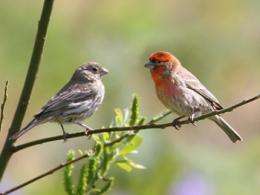The Link Between Birdsong And Human Language

Scientists studying how Bengalese finches use sets of syllables to communicate are a step closer to understanding how humans develop and use vocabulary. After studying the neural networks in finch brains, the researchers developed a model of the neurons in the bird's vocal center.
According to physicist Dezhe Jin, at Penn State University in Philadelphia, both humans and finches rearrange sets of learned syllables to communicate, although finches can create only a few dozen basic syllables while humans draw upon many thousands. The exact arrangement of syllables and words is referred to as syntax.
Because of the parallel between the way humans and the finches handle syllables, Jin said, the finches make the perfect research subjects to study how the brains of both species structure their vocalizations.
"It's very regimentally similar to our syntax," Jin said of the process the finch brain uses to determine what sounds it makes when singing. "Even though we look at [a] primitive species, it can offer insights in to how the human brain works."
Jin used a computer to model a section of the finch's neural passages and simulate how an electrical signal would travel through them. All of the finches' songs start out as a series of electrical signals in the vocal center of the brain and then move out through a series of complex neuron pathways to the region of the brain that controls the finch's voice box. The signal received depends on what chain of neurons the electrical signal followed. A signal flowing through one branch of neurons produces a different sound than a signal following a different chain.
Jin's colleague Alexay Kozhevnikov, also at Penn State, is preparing to test Jin's predictions. In the coming months, Kozhevnikov plans to attach tiny electrodes to the speech centers of a finch's brain. The electrodes will identify which neurons the electric signal travels through while the bird is singing.
"Every syllable will be encoded by a tiny chain of these neurons," Kozhevnikov said, "What you would see is that they would fire during one syllable, but not during another syllable."
Scientists might one day be able to identify how individual neurons control syllables in humans. Ann Graybiel, a researcher from the Massachusetts Institute of Technology in Cambridge, Mass., already has used Jin's model to help identify how a primate's brain keeps track of time. Jin also said that other scientists are looking into using the model to gain insight into why people stutter.
© 2009 Inside Science News Service
















